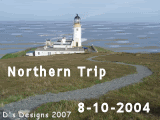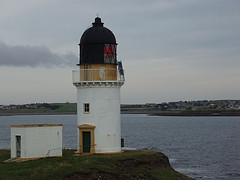Sunday, 25 September 2005
The Iolaire Disaster
On New Year's Eve 1918, a group of sailors from the Isle of Lewis were heading home after 4 years of war. They had gathered at the dockside of Kyle of Lochalsh, 80 miles west of Inverness. The group was too large to be carried on board the regular ferry, the Sheila. The Navy decided to charter HMY Iolaire [Eagle] to carry everybody home in time for Hogmanay. Unfortunately, the weather was poor at the time, and the vessels sailed too late for an arrival at Stornoway before midnight. At 7.30 pm, Iolaire cast off and headed north into the Little Minch. Six hours later, after a rough crossing, the yacht approached Stornoway Harbour. A fishing boat noticed the Iolaire on its approach to the harbour and the skipper did think it was bearing quite far to starboard. This assessment was correct. At 1.30 a.m., on January 1st 1919, the Iolaire ran aground on the Beasts of Holm, a reef 2 miles south of Stornoway. Although these rocks are only 20 yards from shore, it proved to be very difficult to gain the shore. There was quite a swell running, and the strong winds made it practically impossible to launch a salvage operation. Furthermore, the flares, let off by Iolaire as a distress signal were observed in the town, but people thought they were let off in celebration. Sailors jumped overboard from Iolaire with a cable round their waist to establish a link to shore. The lifeboats were unusable. Ninety minutes after the stranding, the boiler exploded, the Iolaire turned 90° and sank. Two hundred and five sailors drowned in the dark waters of Stornoway Harbour. The coastguard managed to save 75 men. The bodies of 205 were retrieved from the waters around Stornoway in the hours, days and weeks after the disaster. The fiery beacons that were due to be lit to celebrate the homecomings after the war remained dark and cold. Every village and family has been affected by this catastrophe. Remember that the population of Lewis at this time was only 14,000. The last survivor of the Iolaire disaster died in 1992. The people of the island have always found it very hard to discuss the catastrophe. After the loss of 205 souls, the island plunged into a deep depression. In 1923, the Canadian government advertised in the Stornoway Gazette for young folk to come over to work in agriculture and industry. Four hundred boarded ships like Metagama to start a newlife in the new world. To this day, young people leave the island after secondary school to go to university on the mainland or find a job.
Subscribe to:
Post Comments (Atom)












No comments:
Post a Comment